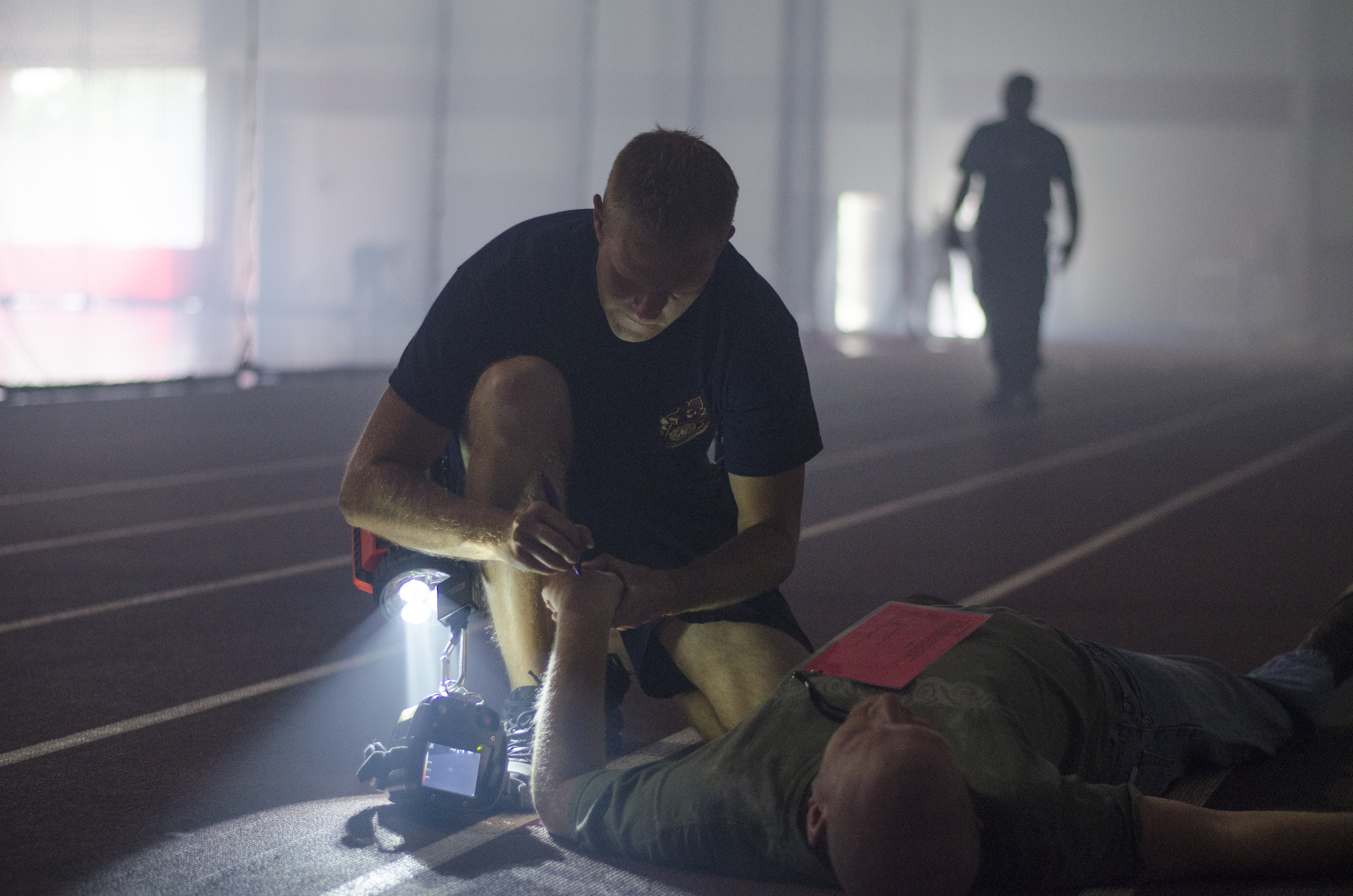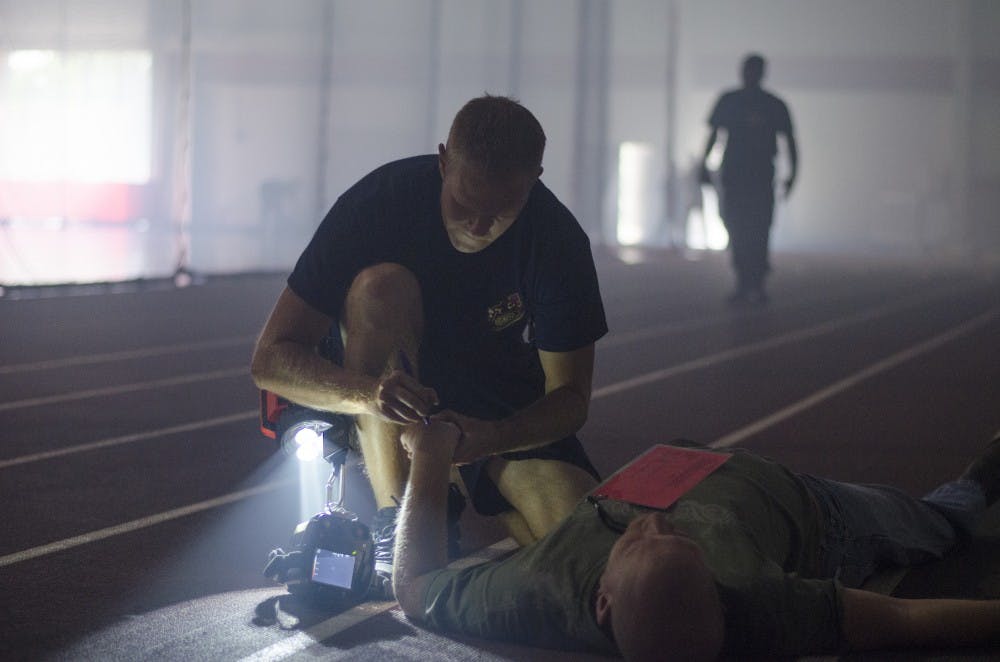34 school shootings have occurred so far in 2014
Indiana school shootings since 2001:
April 21, 2014, in Griffith: A man fatally shot his estranged wife in the parking lot of St. Mary Catholic School and later shot himself after police confronted him.
Jan. 21, 2014, at Purdue University: Student Cody Cousins, 23, shot and killed graduate student Andrew Boldt, 21, on campus during class. Cousins was arrested and charged with murder.
March 25, 2011, in Martinsville: Michael Phelps, a 15-year-old student who had recently been suspended and awaiting expulsion, shot 15-year-old Chance Jackson. Jackson was flown to a hospital and survived his injuries.
March 30, 2001, in Gary: A 17-year-old former student shot Neal Boyd, 16, in the head, an injury that killed him in the parking lot of Lew Wallace High School.
Source: theindychannel.com and CNN

|
| Muncie firefighter Austin Rich marks a volunteer victim during the crisis drill June 7 at the Field Sports Building. Emergency medical services and firefighters used the drill to learn how to handle an emergency situation. DN PHOTO BREANNA DAUGHERTY |
Many medics, injured “victims” and ambulances came to campus Saturday for an emergency drill, but one element wasn’t on hand — preparation for the type of “active shooter” events that have devastated college campuses.
34 school shootings nationally have occurred so far in 2014Indiana school shootings since 2001:April 21, 2014, in Griffith: A man fatally shot his estranged wife in the parking lot of St. Mary Catholic School and later shot himself after police confronted him. Jan. 21, 2014, at Purdue University: Student Cody Cousins, 23, shot and killed graduate student Andrew Boldt, 21, on campus during class. Cousins was arrested and charged with murder. March 25, 2011, in Martinsville: Michael Phelps, a 15-year-old student who had recently been suspended and awaiting expulsion, shot 15-year-old Chance Jackson. Jackson was flown to a hospital and survived his injuries. March 30, 2001, in Gary: A 17-year-old former student shot Neal Boyd, 16, in the head, an injury that killed him in the parking lot of Lew Wallace High School. Source: theindychannel.com and CNN |
Volunteers with fake wounds were lying in the Field Sports Building, waiting for help. In the scenario, a bomb had gone off, seriously wounding 28 and killing six.
The training began with one call over the radio: “1027 West Neely on explosion.” Two minutes later, Ball State police officers rushed into the dark, smoky volleyball and track building with their guns drawn, walking around victims to ensure there was no continuing threat.
Minutes later, fire trucks, ambulances and buses arrived. But that was when the semblance of a real emergency, at least for one on campus, ended.
Emergency medical service responders walked into the building. Several, instead of asking the victims what their injuries were, simply read the card hanging around their necks for an injury report.
The mood was less rush and more drudgery, as emergency workers walked with the pretend dead or dying victims, joking with many of them, instead of carrying them. One emergency worker asked a person to “hop up here” on a stretcher, even though the volunteer victim’s injuries were severed legs.
Braderick Morrison, a junior public relations major, volunteered his Saturday by pretending to be a passerby who was struck in the head with flying debris. He had previously been a part of a similar emergency training exercise in high school and said that event had been taken much more seriously.
“[This event] is more going through the motions and less ‘lets’s make it real,’” he said. “If you want to get experience, they should make it more real.”
The training, based on the Boston Marathon bombing in 2013, took place after an academic year that saw a false report of a gunman on Ball State’s campus. That night, an Eaton police officer accidentally fired his assault rifle into the ground as he stood near students. The weapon hit the street under his feet on Neely Avenue.
In January, the nation saw more than 11 school shootings — including one at Purdue University where a graduate student was killed in a classroom.
However, Saturday’s training that brought Ball State police together with several other local and state emergency response teams wasn’t based on an event happening on a college campus, said Alan Hargrave, crisis management team chair at Ball State.
The location was picked because they have an agreement to work together in the case of an emergency — the training is just part of getting the agencies together.
“It makes all of us stronger,” Hargrave said. “If you have a large event, none of us have the resources to deal with that event.”
And while the training took place in the same complex where the gunman was reported to be in last fall, he said that was not the reason for training there.
Hargrave said the university conducts several exercises each year where security and emergency response workers role-play an emergency response without actually involving police and aid workers.
David Bell, University Police Department training coordinator, said Saturday’s training allowed police to practice working with different departments and to share information, something the department learned it didn’t do well during the November false gunman report.
“We found out that was a challenging response for us,” Bell said.
Incidents around the country often involve an “active shooter” where a gunman walks on campus, hunting victims through classrooms and other buildings, but Saturday’s training did not prepare for this. The only police members on scene were from Ball State UPD and the practice was more focused on dealing with injured people.
Muncie Fire Department’s Lt. Chris Spencer said training allows crews to “slow it down” and check for the little things that could be overlooked in an emergency.
Although the event was supposed to be realistic, MFD Sgt. Tim Smalley said he couldn’t treat training like a real emergency because there is no substitute for the real thing.
“When you pull someone out dead, it is a whole lot different instead of just saying, ‘These are the tags,’” he said.





